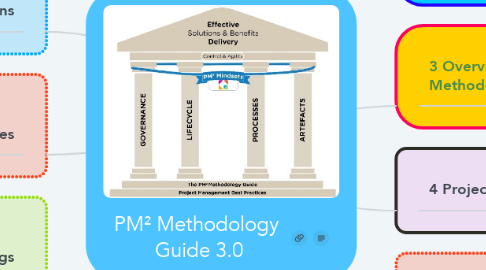
1. 2 Project Management
1.1. 2.1 About Projects
1.1.1. 2.1.1 What is a project?
1.1.2. 2.1.2 Why we do projects
1.1.3. 2.1.3 Project outputs, outcomes, benefits
1.2. 2.2 About Project Management
1.2.1. 2.2.1 What is Project Management?
1.2.2. 2.2.2 Project Documentation
1.2.3. 2.2.3 The Project Support Office (PSO)
1.2.4. 2.2.4 Programme Management
1.2.5. 2.2.5 Project Portfolio Management
1.2.6. 2.2.6 Projects vs Operations
1.3. 2.3 Project Environment
1.3.1. 2.3.1 Project Organisation
1.3.2. 2.3.2 Developing Project Management Competences
1.3.3. 2.3.3 Project Management Competences
2. 1. An Introduction to the PM² Guide
2.1. 1.1 Objectives
2.2. 1.2 Intended Audience
2.3. 1.3 About the PM² Methodology
2.4. 1.4 The Centre of Excellence in PM² (CoEPM²)
2.5. 1.5 The Open PM² Initiative
2.5.1. 1.5.1 Open PM² Publications
2.5.2. 1.5.2 Project Support Network (PSN)
3. 3 Overview of the PM² Methodology
3.1. 3.1 The House of PM²
3.2. 3.2 The PM² Lifecycle
3.2.1. 3.2.1 Initiating Phase
3.2.2. 3.2.2 Planning Phase
3.2.3. 3.2.3 Executing Phase
3.2.4. 3.2.4 Closing Phase
3.2.5. 3.2.5 Monitor & Control
3.2.6. 3.2.6 Phase Gates and Approvals
3.3. 3.3 PM² Phase Drivers and Key Artefacts
3.4. 3.4 What is a PM² Project
3.5. 3.5 PM² Mindsets
3.6. 3.6 Tailoring and Customisation
3.7. 3.7 PM² and Agile Management
4. 4 Project Organisation and Roles
4.1. 4.1 Project Stakeholders
4.2. 4.2 Project Organisation: Layers and Roles
4.3. 4.3 Appropriate Governance Body (AGB)
4.4. 4.4 Project Steering Committee (PSC)
4.5. 4.5 Project Owner (PO)
4.6. 4.6 Solution Provider (SP)
4.7. 4.7 Business Manager (BM)
4.8. 4.8 Project Manager (PM)
4.9. 4.9 Business Implementation Group (BIG)
4.10. 4.10 Project Core Team (PCT)
4.11. 4.11 Project Support Team (PST)
4.12. 4.12 RAM (RASCI) — Documenting Responsibility Assignments
5. 5 Initiating Phase
5.1. 5.1 Initiating Meeting
5.2. 5.2 Project Initiation Request
5.3. 5.3 Business Case
5.4. 5.4 Project Charter
5.5. 5.5 Phase Gate RfP (Ready for Planning)
6. 6 Planning Phase
6.1. 6.1 Planning Kick-off Meeting
6.2. 6.2 Project Handbook
6.2.1. 6.2.1 Project Roles & Responsibilities
6.2.2. 6.2.2 Project Management Plans
6.2.3. 6.2.3 Project-Specific Plans
6.2.4. 6.2.4 Domain-Specific Artefacts
6.2.5. 6.2.5 Other
6.3. 6.3 Project Stakeholder Matrix
6.4. 6.4 Project Work Plan
6.4.1. 6.4.1 Work Breakdown
6.4.2. 6.4.2 Effort & Cost Estimates
6.4.3. 6.4.3 Project Schedule
